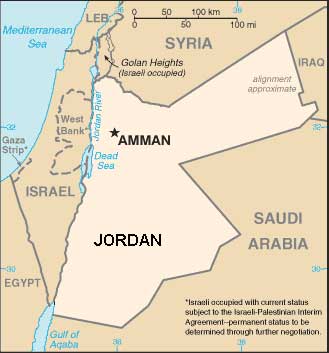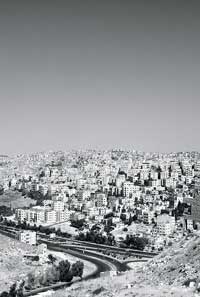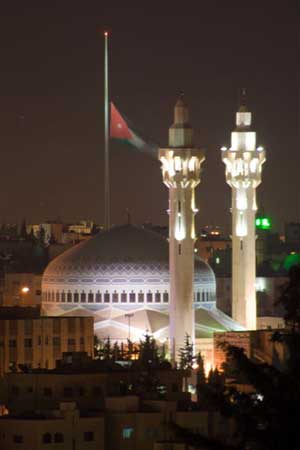Amman, Jordan
 |
| Location
of Amman within Jordan |
Amman, sometimes spelled Ammann, is the capital city
of the Hashemite Kingdom of Jordan, a city of 2,125,400 inhabitants
(2005 estimate), the administrative capital and commercial centre
of Jordan and the capital city of Amman Governorate.
History
Throughout history, Amman has been inhabited by several
civilizations. The first civilization on record is during
the Neolithic period, around 6500 BC, when archaeological
discoveries in 'Ain Ghazal, located in eastern Amman, showed
evidence of not only a settled life but also the growth of
artistic work, which suggests that a well-developed civilization
inhabited the city at that time. In the 13th century BC Amman
was called Rabbath Ammon or Rabat Amon by the Ammonites, Standard
Hebrew Rabbat 'Ammon, Tiberian Hebrew Rabbat 'Ammôn). It was
later conquered by the Assyrians, followed by the Persians,
and then the Greeks. Ptolemy II Philadelphus, the Hellenic
ruler of Egypt, renamed it Philadelphia. The city became part
of the Nabataean kingdom until AD 106 when Philadelphia came
under Roman control and joined the Decapolis —
In 324 AD, Christianity became the religion of the
empire and Philadelphia became the seat of a bishopric during
the beginning of the Byzantine era. One of the churches of
this period can be seen on the city's Citadel.
 |
South Amman
(view from Abdoun), 2005 |
Philadelphia was renamed to Amman during the Ghassanian
era, and flourished under the Caliphates (with nearby capital)
of the Ummayads (in Damascus) and the Abbasids (in Bagdad).
It was then destroyed by several earthquakes and natural disasters
and remained a small village and a pile of ruins until the
Circassians settlement in 1887. The tide changed when the
Ottoman Sultan decided to build the Hejaz railway, linking
Damascus and Medina, facilitating both the annual haj pilgrimage
and permanent trade, putting Amman, a major station, back
on the commercial map.
In 1921, Abdullah I chose Amman as seat of government
for his newly created state, the Emirate of Transjordan, and
later as the capital of the Hashemite Kingdom of Jordan. As
there was no palatial building, he started his reign from
the station, with his office in a train car. Amman remained
a small city until 1948, when the population expanded considerably
due to an influx of Palestinian refugees as a result of them
leaving the newly-created state of Israel. Amman has experienced
exceptionally rapid development since 1952 under the leadership
of two Hashemite Kings, Hussein of Jordan and Abdullah II
of Jordan.
The city's population continues to expand at a dizzying
pace (fueled by refugees escaping the wartime events in Palestine
and Iraq). The city received refugees from these countries
on a number of occasions. The first wave of Palestinian refugees
arrived from the Occupied Territories and Israel proper in
1948. A second wave after the Six Day War in 1967. A third
wave of Palestinian refugees arrived in Amman from Kuwait
after the Gulf War of 1991. Many of the Palestinians that
had been residing and working in Kuwait decided to support
Saddam Hussein's invasion of the country, and so when the
Kuwaiti royal family retook control of the country, they were
expelled. The first wave of Iraqi refugees settled in the
city after the first Gulf War, which reduced Iraq's socio-economic
level dramatically. A second wave also began arriving after
the invasion and occupation of Iraq in 2003, which greatly
increased insecurity in the country as a whole. During the
last 10 years the amount of new building within the city has
increased dramatically with new districts of the city being
founded at a very rapid pace (particularly so in West Amman),
straining the very scarce water supplies of Jordan as a whole,
and exposing Amman to the hazards of rapid expansion in the
absence of careful municipal planning.
On November 9, 2005, coordinated explosions rocked
three hotels in Amman, shocking and angering the population
of the peaceful city. The Islamist organization, Al-Qaeda,
claimed responsibility. Despite the fact that the birthplace
of since-killed terrorist leader Abu Musab Al-Zarqawi is the
town of Zarqa, less than 30km from Amman, and that it remains
a bastion of support for his ideology, the sheer brutality
of the attacks — they targeted, among other things, a Muslim
wedding procession — caused widespread revulsion across the
widest range of Jordanians.
Geography
Amman is located in a hilly area of north-western
Jordan. The city was originally built on seven hills, but
it now spans over an area of nineteen hills (each known as
a jabal or "mountain"). The main areas of Amman gain their
names from the hills and mountains on whose slopes they lie.
Because of the cooling effects of its location on
a plateau, Amman enjoys four seasons of excellent weather
as compared to other places in the region. Summer temperatures
range from 28 - 35 degrees, but with very low humidity and
frequent breezes. Spring and fall temperatures are extremely
pleasant and mild. The winter sees nighttime temperatures
frequently near zero, and snow is not unknown in Amman, as
a matter of fact it usually snows a couple of times per year.
It typically will not rain from April to September, with blue
skies prevailing. But lately it started to rain in April and
the beginning of May. In fact about half the quantity of rain
Amman and Jordan received in 2006 fell in April.
Transportation
The city's main airport, Queen Alia International Airport,
is situated about 30 minutes south of Amman and hosts the majority
of the air travel to and from the country.
By land, the city has frequent bus
connections to other cities in Jordan as well as to major cities
in neighboring countries; the latter are also served by service
taxis. Internal transport is served by a number of bus routes
and taxis. Service taxis, which most often operate on fixed
routes, are readily available and inexpensive. The main two
bus and taxi stations are Abdali (near the King Abdullah Mosque,
the Parliament and Palace of Justice) and Raghadan (near the
Roman Amphetheatre in Downtown). The city can suffer from considerable
traffic congestion at peak hours, especially during summer months
when affluent vacationers from the Gulf region summer in Amman
to take advantage of its relatively mild weather.
Tourism
 |
| King Abdullah
I Mosque at night |
Much of Amman's tourism is focused
in the older downtown area, which is centered around the old
Souk (a colorful traditional market) and the King Hussein Mosque.
The downtown area (known locally as the Balad) has been completely
dwarfed by the sprawling urban areas that surround it. Despite
the changes, much remains of its old character. For those seeking
the atmosphere of the Old City, it is best to venture to the
district east of Jabal Amman. There, in the bustle of daily
life, you can explore the capital's greatest souqs, fine museums,
ancient constructions, monuments, and cultural sites.
The Citadel hill of Amman, known as
Jabal el Qala, has been inhabited for centuries, important as
a military and religious site. It dates back to Roman and Byzantine
times, and later work was carried out in the early Islamic era.
Remains unearthed at the northern and eastern ends of the Citadel,
possibly date back to the Bronze Age. The Citadel also is home
to the Temple of Hercules which is said to have been constructed
under the Roman imperial ruler Marcus Aurelius who reigned from
AD 161-180, is similar to the Temple of Artemis in Ephesus.
Since Amman resembles Rome, as it is
situated on seven hills, the city was a favorite place for Roman
soldiers and officials. Behind the Roman forum stands a Roman
theatre—the largest theatre in Jordan—with room for 6,000 spectators.
Thought to have been built between AD 138 and AD 161 by the
Roman Emperor Antoninus Pius, it is constructed into the side
of the mountain and is still used for sport displays and cultural
events.
Amman is also home to some of the grandest
mosques in the Middle East, although they compare less favorably
to the ones to be found in Istanbul, Turkey. The newest of these
is the enormous King Abdullah I Mosque, built between 1982 and
1989. It is capped by a magnificent blue mosaic dome beneath
which 3,000 Muslims may offer prayer. The most unusual mosque
in Amman is the Abu Darweesh Mosque atop Jabal Ashrafieh (the
highest point in the city). It is covered with an extraordinary
black and white chequered pattern and is unique to Jordan. It
is striking and visible from quite some distance. In contrast,
the interior is totally free of the black and white scheme.
Instead, there are light colored walls and Persian carpets.
This religious building was erected by one of Amman's Circassian
immigrants.
Unfortunately, a lone, deranged gunman attacked Western tourists during a guided trip to the downtown Roman amphitheatre in September, 2006, shooting five of them, one fatally. The man was immediately apprehended, and claimed to have acted in response to the fighting between Israel and Lebanon during the prior months. Despite this attack, tourism in Amman continues on a daily basis, and the city's tourist locations are generally well-policed. Given Jordan's location in a region that sees frequent conflict and violence, by statistics and by general mood, Amman remains a safe and interesting place to visit. For example, despite this killing, there is little or no violent or petty crime in Amman, especially against visitors, who uniformly report feeling safe at all hours in practically all locations in the city.
Nearby places of interest
Amman is conveniently located for many
Jordanian attractions favoured by tourists. It is a mere 45
minute trip by car to several interesting locations:
• The Baptism
Site (Al-Maghtas in Arabic) on the River Jordan where Jesus
is believed to have been baptized by John
the Baptist
• Mount Nebo where, according
to the Bible, Moses is supposed to have died
• The unique ultra saline waters
of the Dead Sea, home to many first-rate resorts
• Jerash, a city of the Decapolis
and considered one of the most important and best preserved
Roman cities in the Near East
• The Hellenistic ruin of Qasr
al Abd, in the nearby valley of Wadi Seer
• Petra, halfway between Amman
and Aqaba, is one of the most breathtaking places in the world
— see also about Petra
• The beaches at Aqaba, a shipping
port and Jordan's only access to the Red Sea. Just over three
hours from Amman by car, the primarily industrial
character of the town is mitigated by the fact that it
is set between sprawling mountain ranges and boasts some of
the finest coral reefs in the region.
|